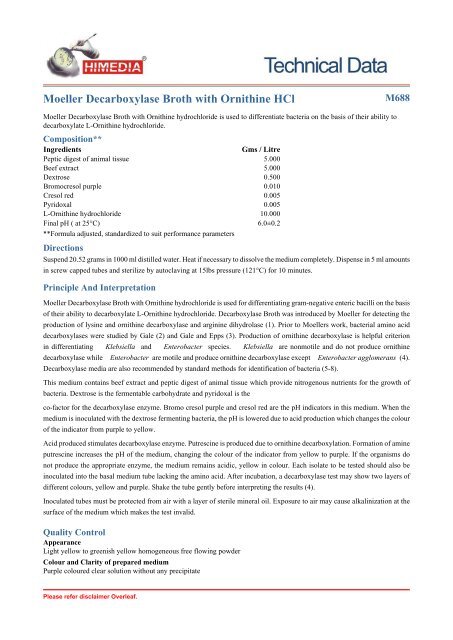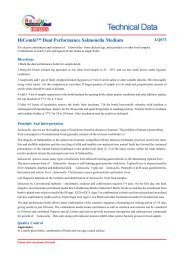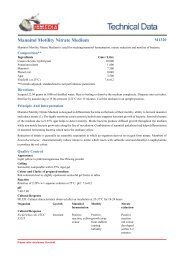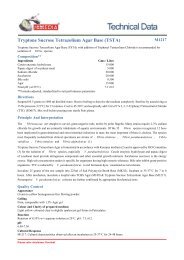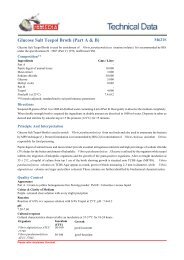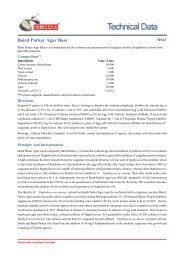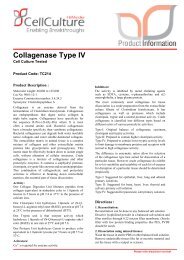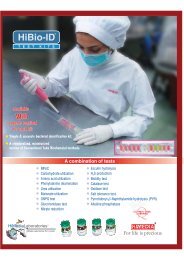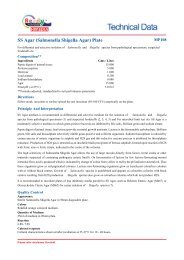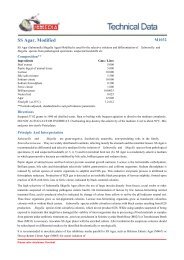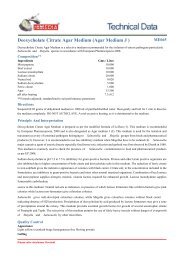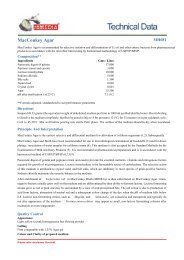Moeller Decarboxylase Broth with Ornithine HCl - Himedia ...
Moeller Decarboxylase Broth with Ornithine HCl - Himedia ...
Moeller Decarboxylase Broth with Ornithine HCl - Himedia ...
You also want an ePaper? Increase the reach of your titles
YUMPU automatically turns print PDFs into web optimized ePapers that Google loves.
<strong>Moeller</strong> <strong>Decarboxylase</strong> <strong>Broth</strong> <strong>with</strong> <strong>Ornithine</strong> <strong>HCl</strong><br />
<strong>Moeller</strong> <strong>Decarboxylase</strong> <strong>Broth</strong> <strong>with</strong> <strong>Ornithine</strong> hydrochloride is used to differentiate bacteria on the basis of their ability to<br />
decarboxylate L-<strong>Ornithine</strong> hydrochloride.<br />
Composition**<br />
Ingredients Gms / Litre<br />
Peptic digest of animal tissue 5.000<br />
Beef extract 5.000<br />
Dextrose 0.500<br />
Bromocresol purple 0.010<br />
Cresol red 0.005<br />
Pyridoxal 0.005<br />
L-<strong>Ornithine</strong> hydrochloride 10.000<br />
Final pH ( at 25°C) 6.0±0.2<br />
**Formula adjusted, standardized to suit performance parameters<br />
Please refer disclaimer Overleaf.<br />
M688<br />
Directions<br />
Suspend 20.52 grams in 1000 ml distilled water. Heat if necessary to dissolve the medium completely. Dispense in 5 ml amounts<br />
in screw capped tubes and sterilize by autoclaving at 15lbs pressure (121°C) for 10 minutes.<br />
Principle And Interpretation<br />
<strong>Moeller</strong> <strong>Decarboxylase</strong> <strong>Broth</strong> <strong>with</strong> <strong>Ornithine</strong> hydrochloride is used for differentiating gram-negative enteric bacilli on the basis<br />
of their ability to decarboxylate L-<strong>Ornithine</strong> hydrochloride. <strong>Decarboxylase</strong> <strong>Broth</strong> was introduced by <strong>Moeller</strong> for detecting the<br />
production of lysine and ornithine decarboxylase and arginine dihydrolase (1). Prior to <strong>Moeller</strong>s work, bacterial amino acid<br />
decarboxylases were studied by Gale (2) and Gale and Epps (3). Production of ornithine decarboxylase is helpful criterion<br />
in differentiating Klebsiella and Enterobacter species. Klebsiella are nonmotile and do not produce ornithine<br />
decarboxylase while Enterobacter are motile and produce ornithine decarboxylase except Enterobacter agglomerans (4).<br />
<strong>Decarboxylase</strong> media are also recommended by standard methods for identification of bacteria (5-8).<br />
This medium contains beef extract and peptic digest of animal tissue which provide nitrogenous nutrients for the growth of<br />
bacteria. Dextrose is the fermentable carbohydrate and pyridoxal is the<br />
co-factor for the decarboxylase enzyme. Bromo cresol purple and cresol red are the pH indicators in this medium. When the<br />
medium is inoculated <strong>with</strong> the dextrose fermenting bacteria, the pH is lowered due to acid production which changes the colour<br />
of the indicator from purple to yellow.<br />
Acid produced stimulates decarboxylase enzyme. Putrescine is produced due to ornithine decarboxylation. Formation of amine<br />
putrescine increases the pH of the medium, changing the colour of the indicator from yellow to purple. If the organisms do<br />
not produce the appropriate enzyme, the medium remains acidic, yellow in colour. Each isolate to be tested should also be<br />
inoculated into the basal medium tube lacking the amino acid. After incubation, a decarboxylase test may show two layers of<br />
different colours, yellow and purple. Shake the tube gently before interpreting the results (4).<br />
Inoculated tubes must be protected from air <strong>with</strong> a layer of sterile mineral oil. Exposure to air may cause alkalinization at the<br />
surface of the medium which makes the test invalid.<br />
Quality Control<br />
Appearance<br />
Light yellow to greenish yellow homogeneous free flowing powder<br />
Colour and Clarity of prepared medium<br />
Purple coloured clear solution <strong>with</strong>out any precipitate
HiMedia Laboratories Technical Data<br />
Reaction<br />
Reaction of 2.05% w/v aqueous solution at 25°C. pH : 6.0±0.2<br />
pH<br />
5.80-6.20<br />
Cultural Response<br />
M688: Cultural characteristics observed after an incubation at 35-37°C for upto 4 days (Inoculated tubes are overlaid <strong>with</strong><br />
sterile mineral oil).<br />
Organism Inoculum <strong>Ornithine</strong><br />
(CFU) decarboxylation<br />
Citrobacter freundii ATCC 50-100 variable<br />
8090<br />
reaction<br />
Enterobacter aerogenes 50-100 positive<br />
ATCC 13048<br />
reaction, purple<br />
colour<br />
Escherichia coli ATCC 50-100 variable<br />
25922<br />
reaction<br />
Klebsiella pneumoniae 50-100 negative<br />
ATCC 13883<br />
reaction, yellow<br />
colour<br />
Proteus mirabilis ATCC 50-100 positive<br />
25933<br />
reaction, purple<br />
colour<br />
Proteus vulgaris ATCC 50-100 negative<br />
13315<br />
reaction, yellow<br />
colour<br />
Pseudomonas aeruginosa 50-100 negative<br />
ATCC 9027<br />
reaction, yellow<br />
colour<br />
Salmonella Paratyphi A 50-100 positive<br />
ATCC 9150<br />
reaction, purple<br />
colour<br />
Salmonella Typhi ATCC 50-100 negative<br />
6539<br />
reaction, yellow<br />
colour<br />
Serratia marcescens ATCC 50-100 positive<br />
8100<br />
reaction,purple<br />
colour<br />
Shigella dysenteriae ATCC 50-100 negative<br />
13313<br />
reaction, yellow<br />
colour<br />
Shigella flexneri ATCC 50-100 negative<br />
12022<br />
reaction, yellow<br />
colour<br />
Shigella sonnei ATCC 25931 50-100 positive<br />
reaction, purple<br />
colour<br />
Storage and Shelf Life<br />
Store below 30°C in tightly closed container and the prepared medium at 2 - 8°C. Use before expiry date on the label.<br />
Reference<br />
1. <strong>Moeller</strong> V., 1955, Acta Pathol. Microbiol. Scand. 36:158.<br />
2. Gale G. F., 1940, Biochem. J., 34:392.<br />
3. Gale and Epps, 1943, Nature, 152:327.<br />
4. MacFaddin J., 2000, Biochemical Tests for Identification of Medical Bacteria, 3rd ed., Williams and Wilkins, Baltimore.<br />
5. Isenberg (Ed.), 1992, Clinical Microbiology Procedures Handbook, Vol. I, ASM, Washington, D. C.<br />
6. FDA Bacteriological Analytical Manual, 8th Ed., AOAC International, Gaithersburg, Md.<br />
7. Eaton A. D., Clesceri L. S. and Greenberg A. E., (Ed.), 1998, Standard Methods for the Examination of Water and<br />
Wastewater, 20th Ed., American Public Health Association, Washington, D.C<br />
Please refer disclaimer Overleaf.
HiMedia Laboratories Technical Data<br />
8. Downes F. P. and Ito K., (Ed.), 2001, Compendium of Methods for the Microbiological Examination of Foods, 4th Ed.,<br />
American Public Health Association, Washington, D.C<br />
Disclaimer :<br />
Revision : 1 / 2011<br />
User must ensure suitability of the product(s) in their application prior to use. Products conform solely to the information contained in this<br />
and other related HiMedia publications. The information contained in this publication is based on our research and development work<br />
and is to the best of our knowledge true and accurate. HiMedia Laboratories Pvt Ltd reserves the right to make changes to specifications<br />
and information related to the products at any time. Products are not intended for human or animal diagnostic or therapeutic use but for<br />
laboratory, research or further manufacturing use only, unless otherwise specified. Statements contained herein should not be considered<br />
as a warranty of any kind, expressed or implied, and no liability is accepted for infringement of any patents.<br />
HiMedia Laboratories Pvt. Ltd. A-516,Swastik Disha Business Park,Via Vadhani Ind. Est., LBS Marg, Mumbai-400086, India. Customer care No.: 022-6147<br />
1919 Email: techhelp@himedialabs.com


